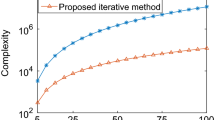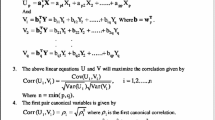Abstract
Independent component analysis (ICA) blindly separates mixed recorded signals and is employed in various engineering disciplines like speech, biomedical, communication, robotics, leakage detection, vibration analysis and machinery fault diagnosis. Order and phase indeterminacies exist in the ICA post processed signals. These indeterminacies appear due to the use of non-linearities in the development of the ICA algorithms which also restrict the practical applications of ICA. This issue of indeterminacies is not very well explored in the research. In the literature, the signals order ambiguity is resolved using various criterion that can order the signals in ascending or descending order based on a defined criteria. Although, in practice, it is required that the separated signals should be in the order of the mixing source signals. Moreover, the phase correction performed in the literature is through complicated signal processing techniques. In this paper, we propose an efficient and more rational signals ordering and phase correction technique. The proposed technique orders the separated signals in the order of the mixing source signals that makes the proposed technique more practical. Further, we have analysed the resultant mixing and un-mixing matrices, to overcome the phase and order ambiguities in the ICA post processed signals. Audio signals have been utilized for simulation purpose. Furthermore, we have utilize the FastICA algorithm to observe the effectiveness of the proposed signals ordering and phase correction technique (SOPCT). The simple mathematical formulation and efficient simulation performance make the SOPCT technique, a best choice for the practical scenarios.













Similar content being viewed by others
Explore related subjects
Discover the latest articles, news and stories from top researchers in related subjects.References
Ameri, M. R., Shokripour, M., Mohammadpour, A., & Nassiri, V. (2013). Parametric independent component analysis for stable distributions. Artificial Intelligence Research, 2, 27–34.
Amishima, T., et al. (2010). Permutation method for ICA separated source signal blocks in time domain. IEEE Transactions on Aerospace and Electronic Systems, 46(2), 899–904.
Baiyan, L., & Jinhua, T. (2011). Overcomplete ica algorithm of speech signal extraction in underdetermined mixtures. International Conference on Electric Information and Control Engineering (ICEICE), pp. 1520–1522.
Bauer, R., et al. (2015). Bridging the gap between motor imagery and motor execution with a brain-robot interface. Neuroimage, 108, 319–327.
Bousse, M., Debals, O., & De Lathauwer, L. (2017). A tensor-based method for large-scale blind source separation using segmentation. IEEE Transactions on Signal Processing, 65(2), 346–358.
Chai, R., et al. (2017). Driver fatigue classification with independent component by entropy rate bound minimization analysis in an EEG-based system. IEEE Journal of Biomedical and Health Informatics, 21(3), 715–724.
Chen, Z., Lian, X., & Yu, Z. (2010). Leakage detection for oil pipelines based on Independent Component Analysis. IEEE 29th Chinese Control Conference (CCC), Beijing, China.
Cheung, Y., & Lei, X. (2001). Independent component ordering in ICA time series analysis. Neurocomputing, 41(1–4), 145–152.
Comon, P. (1994). Independent component analysis, a new concept. Signal Processing, 36(3), 287–314.
Formaggio, E., et al. (2015). Time-frequency modulation of ERD and EEG coherence in robot-assisted hand performance. Brain Topography, 28(2), 352–363.
Gonzalez, E., Gorriz, J., Ramirez, J., & Puntonet, C. (2010). Elitist genetic algorithm guided by higher order statistic for blind separation of digital signals. 36th Annual IEEE Industrial Electronics Society Conference (IECON), pp. 1123–1128.
Hendrikse, A.J., Veldhuis, R. N. J., & Spreeuwers, L. J. (2007). “Component ordering in independent component analysis based on data power.” Proceedings of the 28th Symposium on Information Theory in the Benelux, Enschede, The Netherlands. Eindhoven.
HyvÄrinen, A., & Oja, E. (2000). Independent component analysis: Algorithms and applications. Neural Networks, 13(4–5), 411–430.
Iraji, A., et al. (2015). “Resting state functional connectivity in mild traumatic brain injury at the acute stage: independent component and seed-based analyses.” Journal of neurotrauma 32.14: 1031-1045.
Jin, Q., & Liang, G. (2010). A new algorithm of infomax for small numbers of sound signal separation. International Conference on Artificial Intelligence and Education (ICAIE), pp. 159–162.
Jun, B., Xiao-hong, S., Hai-yan, W., & Xue, Z. (2009). Natural gradient improvement methods in blind source separation, in: 2nd International Congress on Image and Signal Processing, (CISP ’09), pp. 1–5.
Lee, J.-M., Qin, S. J., & Lee, I.-B. (2006). Fault detection and diagnosis based on modified independent component analysis. AIChE Journal, 52(10), 3501–3514.
Lu, W., & Rajapakse, J. C. (2001). Constrained independent component analysis. Advances in Neural Information Processing Systems.
Maroua, A., et. al. (2016). Design and implementation of wireless sensor network monitoring system for leak detection. IEEE International Symposium on Signal, Image, Video and Communications (ISIVC, pp. 7–12), Tunis, Tunisia.
Norman-Haignere, S., Kanwisher, N. G., & McDermott, Josh H. (2015). Distinct cortical pathways for music and speech revealed by hypothesis-free voxel decomposition. Neuron, 88(6), 1281–1296.
Omachi, M., Ogawa, T., & Kobayashi, Tetsunori. (2017). Associative memory model-based linear filtering and its application to tandem connectionist blind source separation. IEEE/ACM Transactions on Audio, Speech, and Language Processing, 25(3), 637–650.
Rimmele, J. M., et al. (2015). The effects of selective attention and speech acoustics on neural speech-tracking in a multi-talker scene. Cortex, 68, 144–154.
Sawada, H., et al. (2004). A robust and precise method for solving the permutation problem of frequency-domain blind source separation. IEEE Transactions on Speech and Audio Processing, 12(5), 530–538.
Sawada, H., Araki, S., & Makino, S. (2011). Underdetermined convolutive blind source separation via frequency bin-wise clustering and permutation alignment. IEEE Transactions on Audio, Speech, and Language Processing, 19(3), 516–527.
Shi, Z., Tan, X., Jiang, Z., Zhang, H., & Guo, C. (2010). Noisy blind source separation by nonlinear autocorrelation. International Congress on Image and Signal Processing (CISP), 7, 3152–3156.
Uddin, Z., et al. (2018). Adaptive step size gradient ascent ICA algorithm for wireless MIMO systems. Mobile Information Systems, 2018, 1–9.
Uddin, Z., et al. (2015). Applications of independent component analysis in wireless communication systems. Wireless Personal Communication, 83(4), 2711–2737.
Uddin, Z., et al. (2015). Independent component analysis based MIMO transceiver with improved performance in time varying wireless channels. KSII Transactions on Internet and Information Systems (TIIS), 9(7), 2435–2453.
Uddin, Z., et al. (2016). Modified infomax algorithm for smaller data block lengths. Springer Wireless Personal Communications, 87(1), 245–267.
Uddin, Z., Ahmad, A., & Iqbal, M. (2017). ICA based MIMO transceiver for time varying wireless channels utilizing smaller data blocks lengths. Wireless Personal Communications, 94(4), 3147–3161.
Widodo, A., Yang, B.-S., & Han, Tian. (2007). Combination of independent component analysis and support vector machines for intelligent faults diagnosis of induction motors. Expert Systems with Applications, 32(2), 299–312.
Xiang, Y., Ng, S. K., & Nguyen, V. K. (2010). Blind separation of mutually correlated sources using precoders. IEEE Transactions on Neural Networks, 21(1), 82–90.
Zarzoso, V., & Comon, P. (2010). Robust independent component analysis by iterative maximization of the kurtosis contrast with algebraic optimal step size. IEEE Transactions on Neural Networks, 21(2), 248–261.
Zhang, N., & Liu, T. (2009). The application of ant colony optimization algorithm in linear-combination blind source separation problem, in: 2nd International Congress on Image and Signal Processing, (CISP ’09), pp. 1–4.
Zhou, G., et al. (2016). Linked component analysis from matrices to high-order tensors: Applications to biomedical data. Proceedings of the IEEE, 104(2), 310–331.
Author information
Authors and Affiliations
Corresponding author
Additional information
Publisher's Note
Springer Nature remains neutral with regard to jurisdictional claims in published maps and institutional affiliations.
Rights and permissions
About this article
Cite this article
Uddin, Z., Orakzai, F.A. & Qamar, A. Order and phase ambiguities correction in the ICA based separation of speech signals. Int J Speech Technol 23, 459–469 (2020). https://doi.org/10.1007/s10772-020-09709-8
Received:
Accepted:
Published:
Issue Date:
DOI: https://doi.org/10.1007/s10772-020-09709-8




